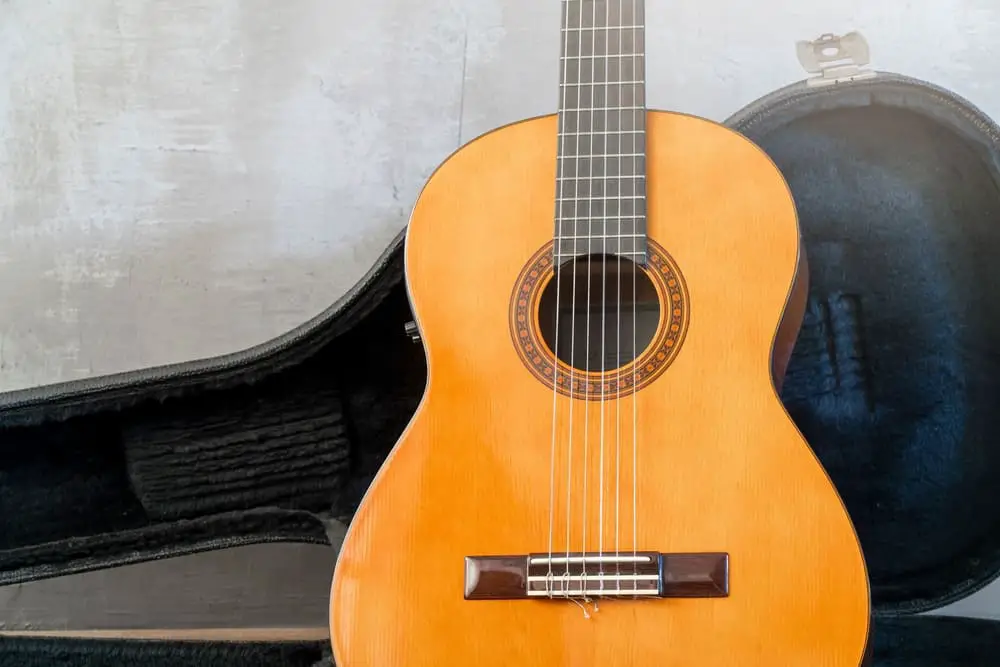
Lovers of guitars are most concerned with playing rather than analyzing what guitars look like. This is understandable because of the enjoyment that comes with playing. That said, there are times you’ll be faced with the daunting task of telling the difference between acoustic and classical guitar. While these guitars might look similar, there are key differences to keep in mind.
The difference between acoustic and classical guitars lies in their body construction, string type, sound quality, and playing style.
So, the purpose of this guide is for you to better understand the distinctions between these two musical instruments. It will help you decide when choosing a classical or acoustic guitar.
It is vital to take an in-depth look into what makes acoustic guitar different from classical guitar. Therefore, we will cover all you need to know about their differences in this ultimate guide.
Acoustic Guitar vs. Classical Guitar – The Differences


Here’s an overview of the fundamental differences between acoustic guitar and classical guitar;
Body Construction
At first glance, the body shape of both guitars looks similar. You will have to look closely to spot the difference. The body shape of the acoustic guitar looks more extensive than that of the classical guitar. Here are some body shape features that will give you a clear view of their difference;
- Neck Size: classical guitars have a much wider neck than acoustic guitars
- Volume Size: classical guitars have less volume compared to acoustic guitars
- Internal Bracing: acoustic guitars have a lot more internal bracing to offer support
- Tuning Pegs: classical tuning pegs are plastic while acoustic tuning pegs are metal
- Bridge Type: bridge pens secure steel strings while nylon strings are tied to the bridge
Classical guitars are traditional in design because they have a relatively wider fretboard to add strength and stability to the guitar’s neck. The lack of fret markers is also very evident in their appearance. Whereas the acoustic guitars have an evident modern body shape design.
String Type
When it comes to string type, the difference between acoustic and classical guitars is glaring.
The acoustic guitar’s strings are made of steel, while the classical guitar’s strings are made of nylon. Guitars have six strings with their notes listed from low to high (E A D G B E).
The nylon strings of classical guitars require low tension, making them ideal for beginners.
But the steel strings of acoustic guitars are perfect for professional players because they need more tension.
Sound Quality
The difference in sound lies in the type of strings used.
The Sound of Classical Guitars
Classical guitars produce a soft and mellow sound. This is due to the thickness of its nylon strings.
The treble strings (G, B, and High E) on classical guitars feature nylon monofilament. At the same time, the bass strings (E, A, D) have a multifilament core with a copper finish. This explains why classical guitars sound different.
The Sound of Acoustic Guitars
Acoustic guitars with steel strings produces a crisper sound. This resonates more than the sound produced by classical guitars.
The metal strings found on acoustic guitars have a nickel and bronze finish. This makes them sharper and harder on the fingers when playing the guitar.
From a sound engineering standpoint, acoustic guitars are preferred in musical bands.
Guitars can go out of tune if you’ve played for an extended period. So, you should always tune your guitar every time you play it. Check out the article about standard tuning for tuning ideas
Playing Style


The playability nature of acoustic guitar is quite different from classical guitar. When it comes to playing style, the posture of the guitarist comes to play.
Classical guitarists are more likely to position the guitar body on their left leg, while acoustic guitarists are more likely to position it on their right leg. Acoustic guitarists can also stand while playing, but classical guitarists never stand when they play.
Also, there’s a notable difference in left-hand and right-hand placement. The thumb placement on the back of the neck is a significant difference between acoustic and classical guitars.
Acoustic guitarists place their left-hand thumb above the guitar’s neck, while classical guitarists place their left-hand thumb lower down the back of the guitar’s neck. While this is the general take, opinions can differ in this regard. For instance, playing the back chord might differ.
As for the right-hand posture, the playing technique is different for both guitars. Classical guitarists fingerpick the strings with their right hand, while acoustic guitarists usually pluck the strings with a plastic plectrum. Acoustic guitarists can fingerpick if they want.
The difference in acoustic and classical guitar playing styles is a robust topic. You can dive into the details by learning how to choose the most suitable guitar playing styles.
Conclusion
This guide shows that the distinction between acoustic and classical guitars is visible in the body construction, string type, and playing style. The quality of sound each one produces is also different. Despite these differences, both classical and acoustic guitars are good to own.
The similarities can cause confusion when deciding which one to choose. However, understanding the differences will help you make an informed decision about the right one for you. Overall, you need to evaluate what you want in a guitar and decide based on preference. Both guitars are great, so you can’t go wrong with your choice of guitar.
Finally, choose the guitar that suits your playing style and the one you feel comfortable with.
Frequently Asked Questions
The classical guitar is better for beginners and younger players because of its softer tone and reduced tension. However, the acoustic guitar is better for steeper learning.
As a beginner, learning to play acoustic guitar is more complex than learning to play classical guitar. But don’t dwell on this mindset. Learning to play acoustic guitar can be easy if you’re focused and dedicated to your guitar lessons.
Electric guitars are the easiest to play — credit to the thinner strings that allow easy press down when playing. The narrower neck also helps with the early stages of playing the guitar.









